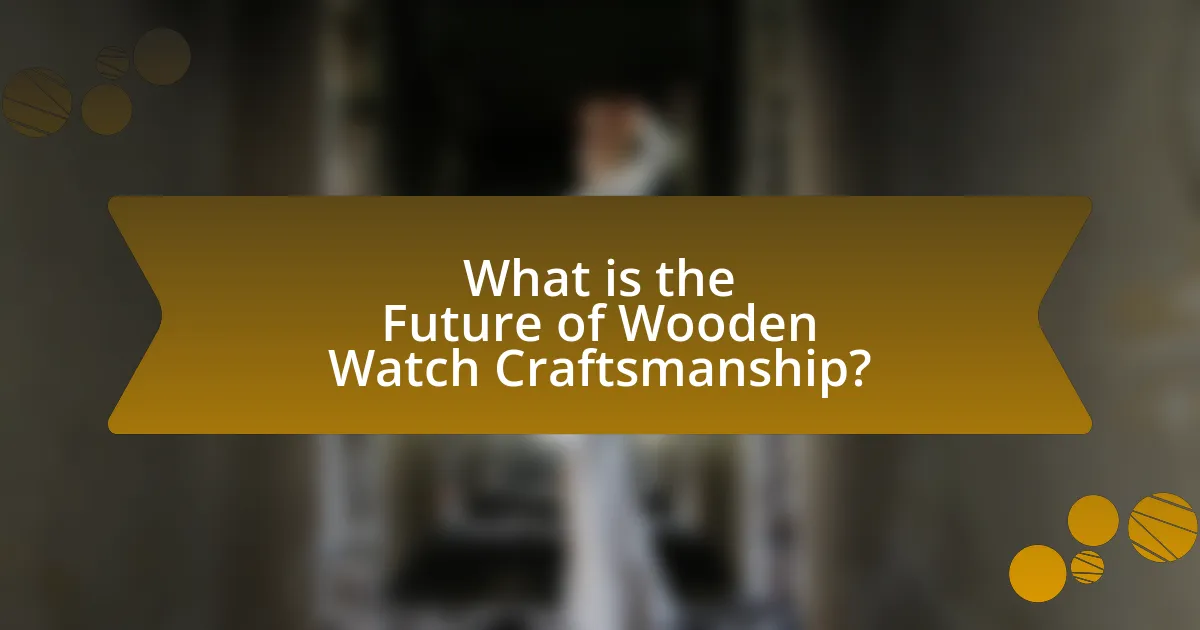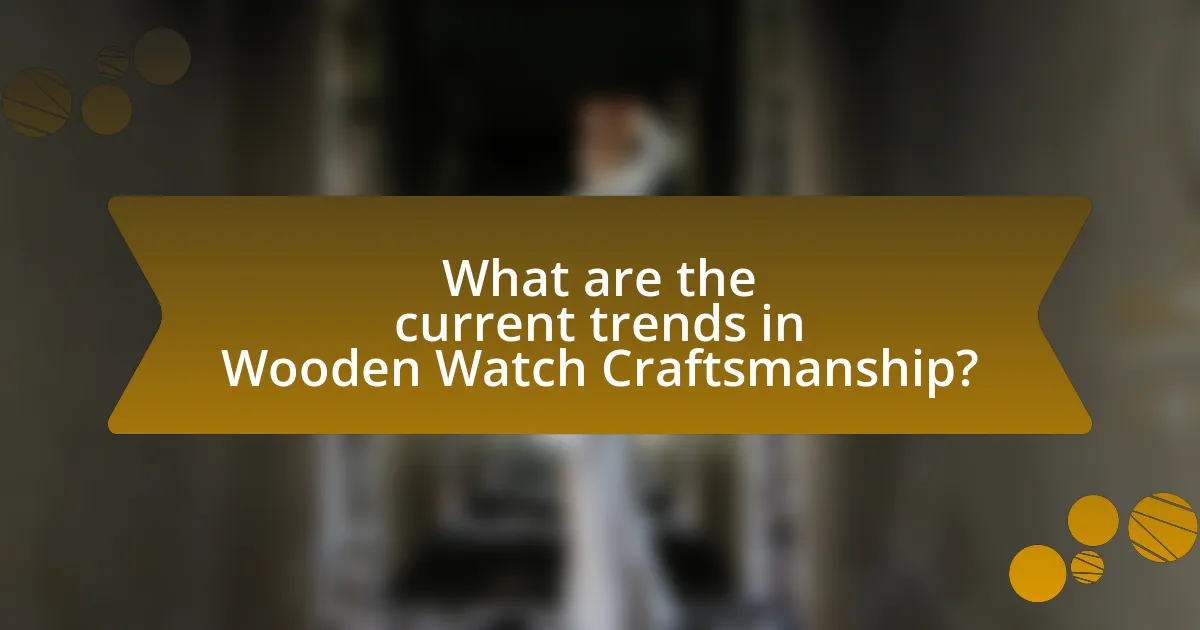The main entity of the article is wooden watch craftsmanship, which is evolving in response to increasing consumer demand for sustainable and eco-friendly products. The article outlines key trends and innovations shaping the future of this industry, including advancements in technology, sustainable sourcing practices, and the integration of smart features. It discusses how artisans are balancing traditional techniques with modern innovations, the influence of consumer preferences on design, and the importance of customization. Additionally, the article highlights emerging materials and finishing techniques, as well as the role of collaborations between artisans and technology companies in driving creativity and sustainability in wooden watch design.

What is the Future of Wooden Watch Craftsmanship?
The future of wooden watch craftsmanship is poised for growth, driven by increasing consumer interest in sustainable and eco-friendly products. As environmental awareness rises, artisans are likely to adopt innovative techniques that enhance durability and design while maintaining the natural aesthetic of wood. For instance, advancements in wood treatment processes can improve water resistance and longevity, making wooden watches more appealing to a broader audience. Additionally, the integration of technology, such as smart features in wooden watches, could attract tech-savvy consumers, further expanding the market. This trend aligns with a broader movement towards sustainable luxury, where craftsmanship meets environmental responsibility, ensuring that wooden watches remain relevant in the evolving watch industry.
How is wooden watch craftsmanship evolving in modern times?
Wooden watch craftsmanship is evolving through the integration of advanced technology, sustainable practices, and innovative designs. Artisans are increasingly utilizing computer-aided design (CAD) software to create precise and intricate patterns, enhancing the aesthetic appeal and functionality of wooden watches. Additionally, the rise of eco-conscious consumerism has led to a greater emphasis on sourcing materials from sustainable forests, ensuring that the production process aligns with environmental standards. For instance, brands like WeWOOD have gained popularity by promoting watches made from reclaimed wood, which not only reduces waste but also appeals to environmentally aware consumers. This shift towards sustainability and technology in craftsmanship reflects a broader trend in the watch industry, where traditional methods are being enhanced by modern innovations to meet contemporary demands.
What are the key factors driving changes in wooden watch craftsmanship?
The key factors driving changes in wooden watch craftsmanship include advancements in technology, increasing consumer demand for sustainable products, and evolving design aesthetics. Technological innovations, such as precision cutting and laser engraving, enhance the quality and intricacy of wooden watches, allowing artisans to create more detailed and unique designs. Additionally, the growing awareness of environmental issues has led consumers to prefer eco-friendly materials, prompting craftsmen to source sustainable wood and adopt environmentally responsible practices. Lastly, shifts in fashion trends encourage the incorporation of modern styles and personalization options, making wooden watches more appealing to a broader audience. These factors collectively influence the evolution of craftsmanship in the wooden watch industry.
How do consumer preferences influence the future of wooden watches?
Consumer preferences significantly influence the future of wooden watches by driving demand for sustainable and eco-friendly products. As consumers increasingly prioritize environmental consciousness, the appeal of wooden watches, which are often made from renewable resources, grows. A 2021 survey indicated that 66% of global consumers are willing to pay more for sustainable brands, highlighting a shift towards eco-friendly purchasing decisions. This trend encourages manufacturers to innovate in design and materials, ensuring that wooden watches remain competitive in a market dominated by metal and plastic alternatives.
What innovations are shaping the future of wooden watch craftsmanship?
Innovations shaping the future of wooden watch craftsmanship include advanced sustainable sourcing techniques, precision CNC machining, and eco-friendly finishes. Sustainable sourcing ensures that wood is harvested responsibly, reducing environmental impact and promoting conservation. Precision CNC machining allows for intricate designs and consistent quality, enhancing the aesthetic appeal and functionality of wooden watches. Eco-friendly finishes, such as natural oils and water-based lacquers, improve durability while maintaining the wood’s natural beauty. These innovations collectively contribute to a more sustainable and high-quality wooden watch industry.
Which new materials are being integrated into wooden watch designs?
New materials being integrated into wooden watch designs include sustainable metals, recycled plastics, and bio-resins. These materials enhance durability and aesthetic appeal while promoting eco-friendliness. For instance, the use of recycled plastics helps reduce waste, aligning with the growing trend of sustainability in fashion. Additionally, bio-resins provide a waterproof and scratch-resistant finish, improving the longevity of wooden watches. This integration reflects a shift towards innovative craftsmanship that prioritizes both environmental responsibility and modern design.
How is technology impacting the craftsmanship of wooden watches?
Technology is significantly enhancing the craftsmanship of wooden watches by integrating precision manufacturing techniques and advanced design software. These innovations allow artisans to create intricate designs with greater accuracy and efficiency, reducing human error and increasing production speed. For instance, computer-aided design (CAD) software enables designers to visualize and modify watch components in real-time, ensuring a perfect fit and finish. Additionally, laser cutting technology allows for precise cuts in wood, which enhances the detail and complexity of watch designs that would be difficult to achieve by hand. This combination of technology and craftsmanship not only improves the quality of wooden watches but also expands the creative possibilities for artisans in the industry.
Why is sustainability important in the future of wooden watch craftsmanship?
Sustainability is crucial in the future of wooden watch craftsmanship because it ensures the responsible sourcing of materials and minimizes environmental impact. As consumer awareness of ecological issues grows, brands that prioritize sustainable practices are more likely to attract environmentally conscious customers. For instance, the Forest Stewardship Council (FSC) certification guarantees that wood used in watchmaking comes from responsibly managed forests, which helps preserve biodiversity and combat deforestation. Additionally, sustainable craftsmanship often incorporates recycled materials and eco-friendly production methods, further reducing the carbon footprint associated with manufacturing. This alignment with sustainability not only enhances brand reputation but also contributes to the long-term viability of the wooden watch industry.
What sustainable practices are being adopted by wooden watch manufacturers?
Wooden watch manufacturers are adopting several sustainable practices, including sourcing wood from certified sustainable forests, utilizing eco-friendly finishes and adhesives, and implementing recycling programs for materials. These manufacturers often obtain wood from sources that adhere to standards set by organizations like the Forest Stewardship Council, ensuring responsible forestry practices. Additionally, many brands are shifting towards biodegradable materials for components and packaging, reducing environmental impact. For instance, some companies have reported using water-based finishes that minimize harmful emissions, aligning with global sustainability goals.
How does sustainability affect consumer choices in wooden watches?
Sustainability significantly influences consumer choices in wooden watches by driving demand for eco-friendly products. Consumers increasingly prefer wooden watches made from sustainably sourced materials, as they align with their values of environmental responsibility. A survey by Nielsen found that 66% of global consumers are willing to pay more for sustainable brands, indicating a strong market trend towards eco-conscious purchasing. Additionally, brands that emphasize sustainable practices, such as using reclaimed wood or ensuring responsible forestry, often see enhanced brand loyalty and customer satisfaction, further reinforcing the impact of sustainability on consumer behavior in this niche market.
How do trends in design influence wooden watch craftsmanship?
Trends in design significantly influence wooden watch craftsmanship by dictating aesthetic preferences, material choices, and production techniques. For instance, the rise of minimalism has led artisans to create simpler, more streamlined designs that emphasize the natural beauty of wood, often resulting in watches with fewer embellishments and a focus on clean lines. Additionally, sustainability trends have prompted craftsmen to source reclaimed or sustainably harvested wood, aligning with consumer demand for eco-friendly products. This shift not only enhances the appeal of wooden watches but also encourages innovation in finishing techniques and durability, as artisans seek to meet the expectations of a more environmentally conscious market.
What role does customization play in the future of wooden watches?
Customization will play a pivotal role in the future of wooden watches by enhancing consumer engagement and personal expression. As consumers increasingly seek unique products that reflect their individual styles, brands that offer customizable features—such as engravings, interchangeable straps, and personalized designs—will likely see a competitive advantage. Research indicates that 70% of consumers are more likely to purchase a product that can be tailored to their preferences, highlighting the demand for personalization in the market. This trend not only fosters brand loyalty but also allows artisans to showcase their craftsmanship through bespoke creations, ensuring that wooden watches remain relevant in a rapidly evolving industry.

What are the current trends in Wooden Watch Craftsmanship?
Current trends in wooden watch craftsmanship include the use of sustainable materials, advanced technology for precision, and a focus on customization. Sustainable sourcing of wood, such as reclaimed or FSC-certified timber, is increasingly prioritized to appeal to environmentally conscious consumers. Additionally, manufacturers are integrating technology like laser engraving and CNC machining to enhance design accuracy and detail. Customization options, allowing consumers to personalize their watches, are also gaining popularity, reflecting a broader trend in the luxury market towards unique, individualized products. These trends are supported by market research indicating a growing demand for eco-friendly and personalized luxury items.
How are traditional techniques being preserved in modern craftsmanship?
Traditional techniques are being preserved in modern craftsmanship through the integration of artisanal skills with contemporary technology. Craftsmen are increasingly utilizing digital tools to enhance precision while maintaining the hand-crafted quality that defines traditional methods. For example, many wooden watchmakers combine CNC machining with hand-finishing techniques, allowing for intricate designs that honor historical craftsmanship while meeting modern demands for accuracy and efficiency. This blend not only preserves the aesthetic and functional aspects of traditional craftsmanship but also ensures that these skills are passed down through workshops and educational programs, fostering a new generation of artisans committed to maintaining these time-honored practices.
What traditional methods are still relevant today?
Traditional methods such as hand-carving, wood selection, and artisanal finishing techniques remain relevant today in wooden watch craftsmanship. These methods ensure high-quality craftsmanship and unique designs, which are valued by consumers seeking authenticity and sustainability. For instance, hand-carving allows artisans to create intricate details that machines cannot replicate, while careful wood selection enhances the aesthetic and durability of the watches. Additionally, artisanal finishing techniques, like oil or wax treatments, protect the wood and enhance its natural beauty, aligning with contemporary consumer preferences for eco-friendly products.
How do artisans balance tradition and innovation in their work?
Artisans balance tradition and innovation by integrating time-honored techniques with modern design and technology. For instance, many artisans in wooden watch craftsmanship utilize traditional woodworking methods, such as hand-carving and joinery, while also incorporating contemporary materials and precision tools to enhance durability and aesthetics. This dual approach allows them to maintain the authenticity of their craft while appealing to modern consumer preferences for functionality and style. The combination of these elements not only preserves cultural heritage but also fosters creativity, enabling artisans to create unique pieces that resonate with both traditional values and contemporary trends.
What are the emerging styles in wooden watch design?
Emerging styles in wooden watch design include minimalist aesthetics, hybrid materials, and intricate craftsmanship. Minimalist designs focus on clean lines and simplicity, often featuring natural wood grains that highlight the material’s beauty. Hybrid styles combine wood with metals or ceramics, enhancing durability while maintaining an organic look. Intricate craftsmanship showcases detailed engravings and unique shapes, appealing to consumers seeking individuality. These trends reflect a growing demand for sustainable and stylish timepieces, aligning with eco-conscious consumer preferences.
Which design elements are gaining popularity among consumers?
Natural materials, minimalist aesthetics, and sustainable design elements are gaining popularity among consumers in the wooden watch market. The shift towards eco-consciousness has led consumers to favor watches made from responsibly sourced wood, emphasizing sustainability. Additionally, minimalist designs that focus on clean lines and simplicity resonate with modern consumers seeking elegance without excess. According to a 2023 market analysis by Grand View Research, the demand for sustainable and eco-friendly products has increased by 30% in the last five years, highlighting the growing consumer preference for these design elements.
How do cultural influences shape wooden watch aesthetics?
Cultural influences shape wooden watch aesthetics by dictating design elements, materials, and craftsmanship techniques that reflect regional traditions and values. For instance, in Scandinavian cultures, minimalism and natural materials are emphasized, leading to sleek, simple designs that highlight the wood’s grain. In contrast, Asian cultures may incorporate intricate carvings and vibrant colors, showcasing a rich heritage of artistry. These aesthetic choices are often rooted in historical significance; for example, Japanese craftsmanship values precision and attention to detail, which can be seen in the meticulous finishing of wooden watches. Thus, cultural backgrounds not only inform the visual appeal of wooden watches but also enhance their storytelling and emotional connection to wearers.
What market trends are influencing the wooden watch industry?
The wooden watch industry is currently influenced by several key market trends, including sustainability, customization, and technological integration. Sustainability drives consumer preference for eco-friendly products, with a growing demand for watches made from responsibly sourced wood. Customization allows consumers to personalize their timepieces, enhancing emotional connection and brand loyalty. Technological integration, such as the incorporation of smart features into wooden watches, is appealing to tech-savvy consumers, expanding the market reach. These trends reflect a shift towards environmentally conscious and personalized consumer behavior, supported by market research indicating a 20% increase in demand for sustainable products over the past five years.
How is the demand for wooden watches changing globally?
The demand for wooden watches is experiencing a notable increase globally, driven by a growing consumer preference for sustainable and eco-friendly products. According to a report by Grand View Research, the global wooden watch market is projected to grow at a compound annual growth rate (CAGR) of 5.5% from 2021 to 2028, indicating a rising trend in consumer interest. This shift is largely influenced by heightened awareness of environmental issues and a desire for unique, handcrafted items that reflect personal values.
What demographic factors are affecting the wooden watch market?
The wooden watch market is primarily influenced by demographic factors such as age, income level, and environmental consciousness. Younger consumers, particularly millennials and Gen Z, are driving demand for wooden watches due to their preference for sustainable and eco-friendly products. According to a 2021 survey by Statista, 72% of millennials are willing to pay more for sustainable products, which directly impacts the wooden watch market’s growth. Additionally, higher income levels correlate with increased spending on luxury and unique items, including wooden watches, as consumers seek distinctive accessories that reflect their personal values and lifestyle choices. Furthermore, the rising awareness of environmental issues among various demographics has led to a growing market for products made from renewable resources, further supporting the wooden watch industry’s expansion.

What innovations are being introduced in Wooden Watch Craftsmanship?
Innovations in wooden watch craftsmanship include the use of advanced sustainable materials, precision laser cutting technology, and eco-friendly finishes. These advancements enhance the durability and aesthetic appeal of wooden watches while minimizing environmental impact. For instance, manufacturers are increasingly utilizing reclaimed wood and bamboo, which not only reduces waste but also offers unique grain patterns. Additionally, precision laser cutting allows for intricate designs that were previously difficult to achieve, resulting in more detailed and customizable timepieces. Eco-friendly finishes, such as natural oils and water-based lacquers, improve the longevity of the wood while ensuring safety for both the wearer and the environment.
How is technology enhancing the craftsmanship of wooden watches?
Technology is enhancing the craftsmanship of wooden watches by integrating precision manufacturing techniques and advanced design software. These innovations allow artisans to create intricate designs with greater accuracy and consistency, reducing human error. For instance, computer-aided design (CAD) software enables detailed modeling of watch components, which can be tested virtually before production. Additionally, CNC (computer numerical control) machines automate the cutting and shaping of wood, ensuring uniformity and intricate detailing that manual methods may not achieve. This combination of technology and traditional craftsmanship results in higher quality, more durable wooden watches that appeal to modern consumers.
What role does 3D printing play in wooden watch production?
3D printing plays a significant role in wooden watch production by enabling the rapid prototyping and customization of watch components. This technology allows manufacturers to create intricate designs and complex geometries that would be difficult or impossible to achieve through traditional woodworking methods. For instance, 3D printing can produce precise and lightweight parts, such as watch cases and internal mechanisms, which enhances both the aesthetic appeal and functionality of the final product. Additionally, the use of 3D printing reduces material waste, as it allows for more efficient use of wood and other materials, aligning with sustainable practices in craftsmanship.
How are smart features being integrated into wooden watches?
Smart features are being integrated into wooden watches through the incorporation of technology such as fitness tracking, notifications, and Bluetooth connectivity. Manufacturers are embedding sensors and microchips within the wooden casing, allowing these watches to monitor health metrics like heart rate and steps while maintaining the aesthetic appeal of natural wood. For instance, brands like WeWOOD and WoodWatch have developed hybrid models that combine traditional craftsmanship with smart technology, demonstrating that it is feasible to blend functionality with eco-friendly materials. This integration not only enhances user experience but also expands the market for wooden watches by appealing to tech-savvy consumers.
What new techniques are being developed for wooden watch making?
New techniques being developed for wooden watchmaking include advanced CNC machining, which allows for precise shaping and detailing of wooden components, and the use of eco-friendly finishes that enhance durability while preserving the natural aesthetics of wood. Additionally, innovations in wood lamination techniques enable the creation of multi-layered designs that improve structural integrity and visual appeal. These advancements are supported by the growing demand for sustainable materials in luxury goods, as evidenced by a 2022 report from the Global Industry Analysts, which highlights a significant increase in consumer preference for eco-conscious products.
How are artisans experimenting with wood treatment processes?
Artisans are experimenting with wood treatment processes by utilizing innovative techniques such as heat treatment, chemical treatments, and natural oils to enhance durability and aesthetics. For instance, heat treatment involves exposing wood to high temperatures to improve its resistance to moisture and pests, which is crucial for the longevity of wooden watches. Additionally, artisans are exploring eco-friendly chemical treatments that preserve the wood’s natural appearance while providing protection against environmental factors. Research indicates that these methods not only extend the lifespan of wooden products but also allow for greater design flexibility, enabling artisans to create unique finishes and textures that appeal to modern consumers.
What advancements in finishing techniques are being utilized?
Advancements in finishing techniques for wooden watch craftsmanship include the use of advanced sanding technologies, eco-friendly coatings, and precision CNC machining. These techniques enhance the surface quality and durability of wooden components. For instance, advancements in sanding technology, such as robotic sanding systems, provide consistent and uniform finishes, reducing human error and improving efficiency. Eco-friendly coatings, like water-based finishes, offer better protection while minimizing environmental impact. Additionally, precision CNC machining allows for intricate designs and precise cuts, ensuring a high-quality finish that meets modern aesthetic standards.
How are collaborations influencing innovations in wooden watch craftsmanship?
Collaborations are significantly influencing innovations in wooden watch craftsmanship by merging diverse expertise and resources, leading to unique designs and sustainable practices. For instance, partnerships between traditional artisans and modern designers have resulted in the integration of advanced technology, such as laser engraving and eco-friendly finishes, enhancing both aesthetic appeal and functionality. Additionally, collaborations with environmental organizations have prompted brands to adopt sustainable sourcing methods, ensuring that materials are responsibly harvested, which aligns with consumer demand for eco-conscious products. This synergy not only fosters creativity but also drives the industry towards more sustainable practices, as evidenced by brands like WoodWatch, which emphasize both craftsmanship and environmental responsibility in their collaborative efforts.
What partnerships are emerging between artisans and technology companies?
Emerging partnerships between artisans and technology companies focus on integrating traditional craftsmanship with modern technology to enhance production and market reach. For instance, collaborations are forming where artisans utilize digital platforms for e-commerce, enabling them to sell handcrafted wooden watches globally. Additionally, technology firms are providing artisans with tools such as 3D printing and design software, which streamline the design process and allow for customization. These partnerships not only preserve artisanal skills but also leverage technology to improve efficiency and accessibility in the marketplace.
How do collaborations enhance the creative process in wooden watch design?
Collaborations enhance the creative process in wooden watch design by combining diverse skills and perspectives, leading to innovative designs and improved craftsmanship. When designers, artisans, and engineers work together, they can share unique insights about materials, functionality, and aesthetics, resulting in products that are not only visually appealing but also technically advanced. For instance, partnerships between woodworkers and technology experts can integrate smart features into wooden watches, pushing the boundaries of traditional craftsmanship. This collaborative approach has been shown to increase creativity and efficiency, as evidenced by successful brands that have utilized cross-disciplinary teams to launch unique collections, thereby capturing a broader market appeal.
What practical tips can consumers consider when choosing wooden watches?
When choosing wooden watches, consumers should prioritize the type of wood used, as different woods offer varying durability and aesthetics. For instance, hardwoods like teak and mahogany are known for their strength and resistance to wear, while softer woods may be more prone to damage. Additionally, consumers should consider the watch’s craftsmanship, ensuring that the joints and finishes are of high quality to enhance longevity. It is also advisable to check for sustainable sourcing certifications, as this reflects the brand’s commitment to environmental responsibility. Finally, consumers should evaluate the watch’s weight and comfort, as a well-balanced wooden watch will provide a better wearing experience.
















